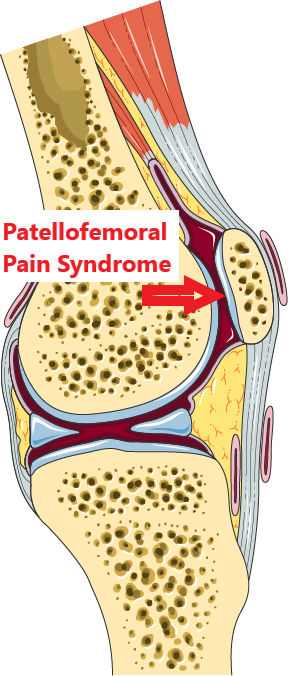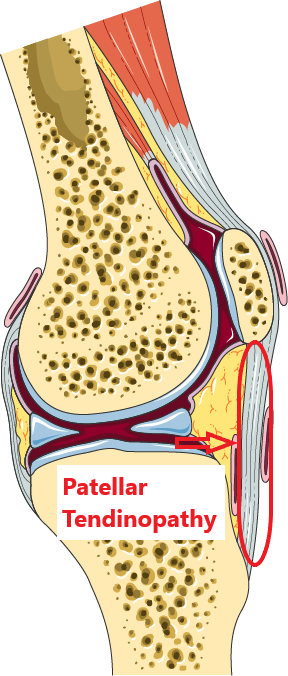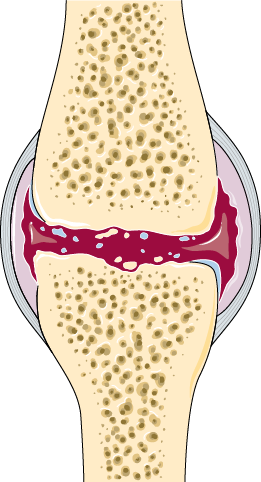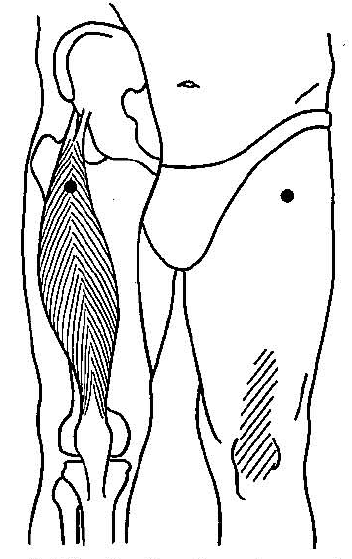Pain at the front of your knee can either be due to an accident or have a slow onset.
When it’s the result of an acute injury you know the origin and it’s just a question matter of figuring out which structure is injured, going from muscle tears, to meniscal tears, bone fractures, bone bruises, and cruciate ligament injuries. If by now you haven’t figured out the origin of your anterior knee pain, I assume the reason you’re here isn’t that you had an acute injury but rather one that came on slowly.
That’s why in this blog I focus on the origins of pain at the front of the knee that isn’t a result of an accident. These include conditions like Patellofemoral pain syndrome, Patellar Tendinopathy, and Myofascial Pain originating from Trigger Points.
Are you ready to figure out why your knee hurts?
Let’s dive in!
1. What is the Origin of Knee Pain in Rock Climbers?
Knee pain in rock climbers comes from a combination of (very) mobile joints and rotational forces and high pressure with movements like heel hooks, toe hooks, and drop knees. Moreover, in boulderers, the jumping and/or falling from boulder problems stresses the knee significantly. To a lesser degree, this also holds for sport climbers taking falls and slamming into the wall.
Before we dive into the knee injuries which might provoke anterior knee pain, let me explain how the aforementioned stressors lead to knee pain.
1.1 (Hyper) Mobility
Hypermobility is a condition that involves an alteration in the quality of the connective tissue. As a result of this, all the joints in your body are very mobile. Even though most climbers don’t have an alteration in the quality of their connective tissue, their joints are flexible because the sport demands it. Even more so if you started at a young age. At the time, your tissues were flexible which you maintained by climbing on.
Heightened flexibility requires more stability to load your joints evenly and reduce the chance of overload. If this stability fails, you’re more likely to develop knee pain.
1.2 Jumping/Falling Down While Bouldering
Falling requires fierce stability and maximum strength capacity. Both of which are often neglected in the lower body of rock climbers. As it’s mainly an upper body strength to weight ratio sport, the lower body is left out of focus.
When you fall this results in unnatural shear forces on the knee joints (kissing knees) and an overload on the tendon and ligaments. These can lead to Patellar Tendinopathy, Patellofemoral pain syndrome, and Osgood Schlatter (I explain what these injuries are later in this article).
1.3 Rotational & Sheer Forces under Pressure
Rotational and sheer forces under pressure while doing drop knees, high steps, heel hooks, toe hooks, and while pressing your knee past your toes to gain stability all cause high amounts of friction in the knee. Depending on the movements of the articular surfaces, the capsule, ligaments, and/or tendons around the knee are affected more or less.
2. 6 Possible Reasons the Front of The Knee Hurts in Rock Climbers
There are several injuries and conditions which result in anterior knee pain. Each of these has a different origin and can be easily diagnosed. Mostly clinical tests are enough but, in some cases, a Röntgen Photo (Osteoarthritis) or MRI (Patellofemoral pain syndrome, Plica Syndrome) can help to make the right diagnosis.
2.1 Patellofemoral pain syndrome
Patellofemoral pain syndrome is pain originating from behind the knee cap. Each patella slides through a groove in the femur (upper leg). This groove provides stability and ensures that forces are transferred efficiently from the upper to the lower leg.
When this sliding mechanism is challenged due to a lack of stability and/or repeated stress on the knee joint the cartilage can get irritated. With or without an inflammation as a result.
I see patellofemoral issues more often in youth and in women. Youth have generally loser joints leaving more space for the patella to move around, and arguably you see it in women more often due to a larger Q-angle. This is the angle between the pelvis and the knees. Women generally have a wider pelvis than men and thus a different load transfer over the knee joint.
Patellofemoral pain syndrome is easily diagnosed:
- Onset: slow, gradual
- Pain behind the patella on palpation
- Pain when moving the patella under compression
- Pain with walking down, walking stairs, jumping, falling, and stop & go
I recently treated two youth rock climbers who both had patellofemoral pain syndrome but, interestingly, didn’t experience any problems with it while rock climbing.

2.2 Patellar Tendinopathy
Patellar tendinopathy is an injury of the patellar tendon which connects the large muscle on top of your upper leg, the quadriceps, to the lower leg. Patellar tendinopathy is an overload injury that comes on slowly provoking pain at the bottom of your knee cap or closer to the insertion on your lower leg.
Patellar tendinopathy has similar symptoms as patellofemoral pain syndrome, the clear difference being the place where the pain is felt.
Diagnosing patellar tendinopathy can be done without any imaging:
- Onset: slow, gradual
- Pain along the patellar tendon
- Pain when extending the knee against resistance (depending on the severity)
- Pain with walking down, walking stairs, jumping, falling, and stop & go

2.3 Osteoarthritis
Osteoarthritis is a possible provoker of pain in the front of the knee. However, before the age of 50, the chance is small that it’s the origin. The older you are the more likely you have some form of osteoarthritis.
What is osteoarthritis?
It’s an autoimmune disorder that reduces the water holding capacity of the proteins in your cartilage. As a result, your cartilage can’t absorb shocks as well and becomes prone to damage. The interesting thing with any degenerative injury is that you can have (a lot of) it without experiencing any symptoms.
To diagnose osteoarthritis as a possible origin of the pain in the front of your knee at least a Röntgen Photo is necessary in combination with the following symptoms:
- Onset: gradual at age 50+
- Pain/stiffness after inactivity (getting out of bed in the morning, standing up from a chair)
- Pain when compressing the joint, bending the knee, and/or with rotational forces
Remember that even if you think you might have osteoarthritis, when you don’t experience symptoms, there’s no reason to go for a radiological investigation. You can live perfectly symptom-free with it.

2.4 Osgood Schlatter
Osgood Schlatter is an inflammation of the insertion of the patellar tendon at the tibia. It’s only seen in boys and girls between the age of 10-15 years old because the epiphysial plates haven’t fully hardened yet. Similar to Patellar Tendinopathy and Patellofemoral pain syndrome, stop & go, jumping, and falling are all risk factors for Osgood Schlatter.
Osgood Schlatter can be diagnosed based on your history and with the help of a Röntgen image. The latter will reveal the injury at the bone.
- Onset: gradual between the age of 10-15 years old
- Pain with descending stairs, running, stop & go, jumping, and falling
- Can be very painful upon touch
2.5 Plica Syndrome
Plica Syndrome is a relatively new diagnosis for a type of knee pain and is uncommon. The medial plica is a piece of connective tissue that can become painful after injury or due to overload.
The main way to figure out if it is the plica that is provoking the pain at front of your knee is by palpating the area. You can provoke your pain by pressing at the inside of your patella, not on top or below it. Another difference with the previous knee injuries is that pain originating from plica tissue doesn’t limit activities as much.
- Onset: gradual or acute
- Pain at the inside of the patella
- Pain with certain activities and at rest
- With or without inflammatory symptoms (redness, swelling, and heat)
2.6 Trigger Points (Myofascial Pain)
Myofascial Trigger points are hard taught bands within muscle fibers where there’s a reduction in blood circulation. This leads to the accumulation of waste products creating an environment that might trigger pain registering nerves. This pain might or might not be felt at the site of the trigger point itself. It’s quite common that trigger points provoke referred pain. Trigger points in the rectus femoris or the vastus medialis muscle can both cause referred pain at the front of the knee.image?

Anterior knee pain originating from trigger points can be diagnosed by:
- Provoking familiar pain when pressing into corresponding muscles
- All tests for the former knee injuries are negative
- Onset of symptoms comes after a sudden increase in training load
3. How to Prevent Pain at the Front of the Knee in Rock Climbers
The best way to prevent pain at the front of the knee in rock climbers is three-fold:
- A properly periodized training plan should allow for the right training stimuli and enough time to recover your training sessions
- Falling from boulders should only be done when you actually fall and not at moments you can climb down. Moreover, it would be a great idea to practice proper falling techniques to increase the lifespan of your knees
- Strength training for the legs makes the muscles around the knee stronger and makes the tendons and ligaments stiffer. This makes them less prone to injury.
